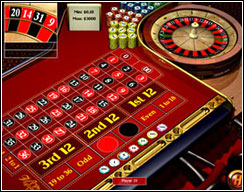 roulette or European roulette. While the essence of the game itself is the same, there is no disputing that from the standpoint of the odds they offer to the player, these forms of roulette are very, very different.
roulette or European roulette. While the essence of the game itself is the same, there is no disputing that from the standpoint of the odds they offer to the player, these forms of roulette are very, very different.Today when we read and talk about roulette, and when we look for it in the context of an online casino, we are always referring to either one or another form of the game - American
 roulette or European roulette. While the essence of the game itself is the same, there is no disputing that from the standpoint of the odds they offer to the player, these forms of roulette are very, very different.
roulette or European roulette. While the essence of the game itself is the same, there is no disputing that from the standpoint of the odds they offer to the player, these forms of roulette are very, very different.
There appears to be evidence that as far back as 1758, there was a game called "roulette" that existed in North America, and it was in the French province of Quebec that this was the case, because it specifically stated in the laws at the time that the game was banned. Since this was over 100 years after Pascal's invention of the wheel, it is virtually certain that the game referred to is that which resembles what we know today.
It was known toward the end of the 18th century that the wheel had a zero and a double zero. However, the single-zero wheel became very popular because there was only one slot that belonged to the house. It is thought to have originated in Germany in 1842, and that would have been though brothers Francois and Louis Blanc in their casino in Hamburg.
At one point when the German government outlawed gambling, the Blancs accepted an offer to buy a casino in Monte Carlo, which was the only place in Europe gambling remained legal. They brought the single-zero roulette wheel with them, and that was the catalyst that enabled roulette to gain its popularity and become a true game of both the people and the elite. It had a dramatic effect on the player's expectation as well, cutting the odds against them from 5.26 to 2.70%.
One of the great parts of roulette mythology involves Francois Blanc's supposed "deal with the devil" in order to unlock all the secrets of roulette. Apparently Blanc pointed out to Lucifer that the numbers on a roulette wheel, added together, came out to 666. Obviously whether you added a zero or double zero, it wouldn't have increased that total.
While Blanc's single-zero wheel became the rave in Europe, the French double-zero wheel made its way with French settlers when they went to America. Since they eventually settled down in Louisiana, that wheel became customary on the riverboat gambling scene. It did not stop there. Wherever gambling was conducted in America, the wheel with two zeros became the custom. And it established the very clear distinction to what has become known as the "American" style of roulette and the "European" style.
Certainly we know that one of the early roulette wheels in America was a little bit different. Not only was it equipped with a double zero, it also had an American Eagle in one of the slots, giving the house three slots in all. If you were to wager on any of those events specifically, you could collect, but wagers on anything else were lost if the ball fell into zero (0), double zero (00) or with the American Eagle.